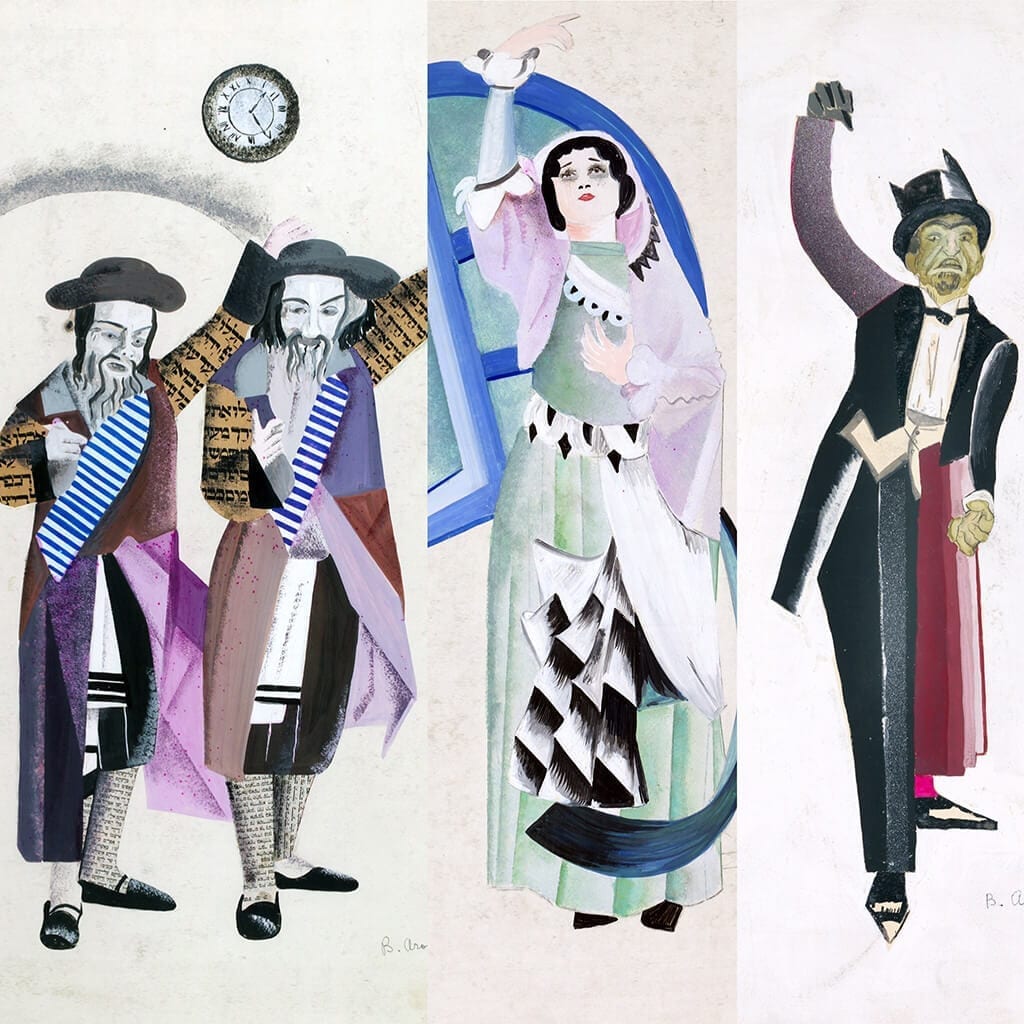Yes, I am sending theater-goers visiting New York not to a play, but to an art gallery on the rarified Upper East Side. Squish-squish-squish go the plushly carpeted stairs up to the fourth floor of the elegant beaux-arts interior of Vallois America. Soon you will see that this exhibit is about as theatrical as it gets. We are confronted with shockingly daring juxtapositions of rich textured patterns, breathtaking angles, characters rendered like Cubist masterworks, as epic as myths. You urgently want to experience these shows, these powerful, colorful figures. This was Yiddish Theatre? Why have I never heard of this guy?
Boris Aronson was nominated for Tony awards for Scenic Design nine times between 1959 and 1976, and won six times—for Zorba, Company, and Follies among others. That was all in addition to the set many people do remember him for–Fiddler on the Roof, with the rotating wheel in the floor that allowed Zero Mostel as Tevye the Dairyman, to resignedly pull his sad wagon from Anatevka, convincingly burdened.
This exhibit concentrates on Aronson’s earlier work, done for the Yiddish theatre that thrived in New York City in the 1920s, a fitting origin story for the set designer of Fiddler. Knowing this, I had imagined I would see realistic sets of quaint shtetl hovels, spaces for stagey, kerchiefed mammelehs to cry in. Hardly! Boris Aronson was an impassioned Modernist, fully part of the cultural dialogue that was exploding in the early twentieth century. His set for The Bronx Express supports a subway reality, boldly interpenetrated with collage elements from a dreamed unreality—palm tree vistas, swatches of bold colored patterns. His unrealized stage design for The Golem is a DeChirico-esque nightmare of overpowering architectural elements, projecting and receding in a black void. When he does give us a shtetl home, its roof is broken into shaded facets; its windows are made from a dozen angles, all straining against their frames.
About half of the fifty or so works on display are costume designs—a pastel-enhanced angel with graphical wing-feathers and garment folds, all straining upward; a towering golem holding his mute, clay-faced head in hands, whose faceted garment resembles a cross-section of Hell and earth. There are winged devils covered with graphical scrollwork, crowned with corrupted holy tablets. His earthly religious figures—dancing Chasidim, a clerical-looking figure—bear the recognizable markers that identify them, alongside clashing collage elements of unexpected colors or swaths of Hebrew text. A man with tallit and phylacteries is rendered into a great, mystical punctuation mark straining for divine connection. Even Aronson’s costume designs for more realistic characters from daily life—a mother and daughters, a middle-aged couple, a dancing man—have a Chagall-like, simultaneously modern and folkloric randomness of color assignment, and a strong graphical imprint that amplifies the essential spirit of the characters. They would doubtless engage the eye and the imagination even from the back row of the balcony.
For those hoping to see at least something from Fiddler, the exhibit does not disappoint. There’s an early set design awash in dreamy blues and greens, with the circle of shtetl houses forming an upside-down firmament over the central weary and settled-looking home, whose uneven roof supports the eponymous fiddler, however precariously. Start the bidding! I’m ready to buy. (I only wish.)
Go. See. Enjoy.
Curated by Galerie Le Minotaure
Vallois America, Upper East Side, New York
Until 23 December 2015











